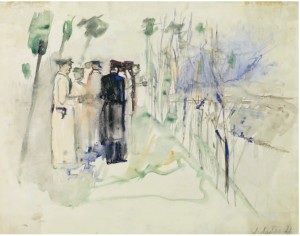In 1927, the art critic and theoretician Yakov Tugendhold described what was happening in Russian art in the early 1920s in the following manner: “Even a work of art that is very revolutionary in its concept may be merely firing a blank shot if its outer form is archaic. Need we repeat the fundamental truth that each and every historical era and new social class had its own way of understanding form and its own language of art?.. Our thematic style of painting developed along a different path than the new leftish style and often rehashed Itinerant naturalism or French impressionism. At the same time, our avant-garde could fertilize that style of painting with its recent achievements in form. No matter how abstract the painting of our abstractionists, suprematists and cubists, it nonetheless affirmed great values which could serve as the foundation for modern art. These values were a new, clear-cut, organized style of painting, so different from the usual, undisciplined lyricism of the Russian brush, and new achievements in the realms of colour, composition, and texture, which had the potential to become powerful tools for expressing emotion.”
Art in the 1920s was still capable of creating or visualizing the world without the restriction of being merely a stage for the state to wield its authority. This art did not have to adapt to anyone or anything:
there was simply no art market in existence, while the state did not at that time make difficult demands on art, having not yet started on its path of total disassociation from independent forms of cultural expression. But that which Ya. Tugendhold noted — the discussion of thematic painting as the task of art — was already a step towards a compromise with the state, which expected art to provide illustrations for the bureaucracy’s political activity. In response to this demand, there began to appear various types of figurativity — artistic expressions that were complimentary to the authorities. Leftish art tried to justify its search for new forms and systems of expression during the time of change, but the very fact that it was necessary to justify oneself and prove one’s right to exist documents the pressure that the state was putting on art.
In the mid-twenties there were significant changes in the art world’s balance of power. The end was approaching for fruitful, unhindered work and free discussion concerning what art should become. In 1932, the Soviet Union saw the passing of a law concerning The Reformation of Literary and Artistic Organizations, which created a new bureaucracy that establishments promoting culture had to work under. Nevertheless, an entire generation of artists had arisen during the fifteen years preceding this low. According to Olga Roytenberg, a historian of Russian art specializing in the 1920s and 1930s, the work of this generation of artists was the main reason why 20th century Russian art did not end up one-dimensional.



